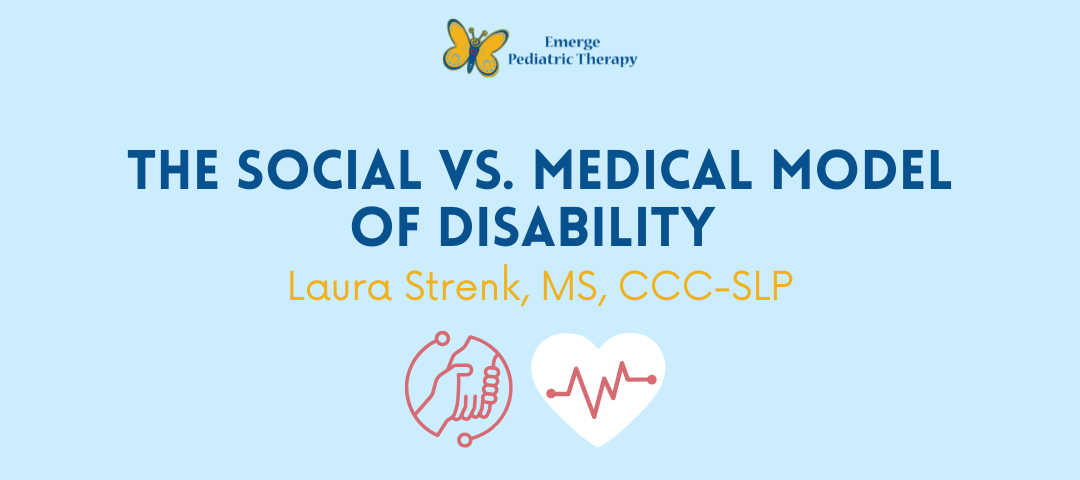
Over the past several years, the Neurodiversity Movement has gained significant momentum on a global scale. With this movement, there have been great strides in Autism awareness, acceptance, and action. The Neurodiversity Movement has centered on listening to and amplifying the voices of neurodivergent people, changing the perception of diagnoses such as Autism and ADHD. Alongside this movement, therapists, teachers, and caregivers are embracing a shift toward more affirming care that honors and uplifts the unique strengths and perspectives of neurodivergent individuals. In order to be in alignment with this movement, medical and educational providers as well as loved ones need to shift their understanding of disability from a “medical model” to a “social model.”
The Medical Model of Disability
The Medical Model of Disability views disability as a problem that exists within the individual, suggesting that disability happens when there is something wrong with a person. Within this framework, therapists are expected to fix the person and help them fit into the same box as everyone else, rather than adapting the environment or recognizing diverse ways of being. Therapists are also responsible for determining which goals the individual should work on, often without fully considering the person’s own priorities or preferences. The ultimate aim of this model is for the disabled person to “overcome” their disability, reinforcing the idea that disability is something inherently negative that must be corrected.
The Social Model of Disability
The Social Model of Disability views disability not as a problem within the individual, but as something that arises when there is a lack of access or support for someone who is different. According to this model, it is society that must change by adjusting expectations, removing barriers, and creating inclusive environments. It recognizes that disabled people have the right to make their own decisions and should be empowered to live their lives on their own terms. The ultimate goal of the social model is to build a society that values access, equity, and the acceptance of human differences.
What does this mean for therapy?
Shifting from a medical to a social model of disability in therapy means rethinking the therapist’s role, the goals of therapy, and how success is defined. Instead of focusing on “fixing” the individual to fit into a standard mold, therapy under the social model emphasizes supporting the person to navigate a world that often isn’t built with their needs in mind. Additionally, it means that therapists should be consulting with their clients in order to figure out what is important to them!
Some examples of how pediatric goals may be different under the medical and social models of disability are included below:
| Goals informed by a Medical Model | Goals informed by a Social Model |
| The child will take turns in conversation. |
The child will inform their communication partner of their communication preferences (which may include info dumping on special interests!). The communication partner will accept all communication preferences. |
| The child will use “whole body listening” by keeping their body still during group activities. |
The child will respect their own unique listening needs by selecting sensory tools and using movement to assist their bodies and minds while learning. Peers and adults will learn about different ways of listening. They will provide support with selecting sensory tools as needed. |
| The child will make verbal requests for items. |
The child will use multimodal communication (to include gestures, sign language, SGD selection, verbal speech, etc.) to resolve communication breakdowns. The communication partner will accept all forms of communication. |
| The child will be desensitized to their noisy classroom environment via routine exposure. |
The child will select and use sensory tools in order to support their comfort in a classroom environment. The child will request breaks from this environment when needed. The classroom environment will be modified to support the child’s sensory differences. Breaks from this environment will be accepted and supported. |
Nuances within these Models of Disability
While shifting from the Medical to Social Model of Disability may seem like a perfect “solution” for more strengths-based, person-centered care, many Autistic people state that the Social Model of Disability oversimplifies and understates the impact that autism can have on daily function. Autistic SLP Rowan LaForce states “A movement that labels autism as simply ‘different’ runs the risk of illegitimizing the struggles of many autistic people with greater support needs.” This means that, while it is important to create greater access and acceptance of differences, we also need to recognize that the differences present in neurodivergent individuals can be disabling and impact daily life, even when accommodations are provided and strengths-based practices are utilized.
Citation:
LaForce, R. (2024, May 6). Autistic SLP looks for increased reconciliation of different approaches. The ASHA LeaderLive. https://leader.pubs.asha.org/do/10.1044/leader.FMP.29052024.asd-approaches-slp.8/full/)
